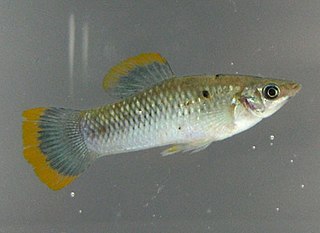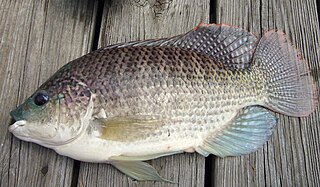
Poecilia is a genus of fishes in the family Poeciliidae of the order Cyprinodontiformes. These livebearers are native to fresh, brackish and salt water in the Americas, and some species in the genus are euryhaline. A few have adapted to living in waters that contain high levels of toxic hydrogen sulfide and a population of P. mexicana lives in caves.

The shortfin mako, also known as the shortfin mako shark, blue pointer, or bonito shark, is a large mackerel shark. It is commonly referred to as the mako shark, as is the longfin mako shark. The shortfin mako can reach a size of 4 m (13 ft) in length and weigh 570 kg (1,260 lb). The species is classified as Endangered by the IUCN.

The sailfin molly is a species of fish of the genus Poecilia. They inhabit fresh, brackish, salt, and coastal waters from North Carolina to Texas and the Yucatán Peninsula of Mexico.
The widemouth gambusia is a species of fish in the family Poeciliidae of the order Cyprinodontiformes. It is endemic to Mexico, specifically to the Baños del Azufre near Teapa, Tabasco. The Baños del Azufre are sulfidic springs that contain high concentrations of toxic hydrogen sulfide. This prevents most animals from living in them; the only other fish found in the toxic sections of Baños del Azufre is the sulphur molly.

Poecilia sphenops is a species of fish, of the genus Poecilia, known under the common name molly; to distinguish it from its congeners, it is sometimes called short-finned molly or common molly. They inhabit fresh water streams and coastal brackish and marine waters from Mexico to Colombia. The wild-type fishes are dull, silvery in color. The molly can produce fertile hybrids with many Poecilia species, most importantly the sailfin molly. The male mollies generally tend to be mildly aggressive.

Eleotridae is a family of fish commonly known as sleeper gobies, with about 34 genera and 180 species. Most species are found in the tropical Indo-Pacific region, but there are also species in subtropical and temperate regions, warmer parts of the Americas and near the Atlantic coast in Africa. While many eleotrids pass through a planktonic stage in the sea and some spend their entire lives in the sea; as adults, the majority live in freshwater streams and brackish water. One of its genera, Caecieleotris, is troglobitic. They are especially important as predators in the freshwater stream ecosystems on oceanic islands such as New Zealand and Hawaii that otherwise lack the predatory fish families typical of nearby continents, such as catfish. Anatomically, they are similar to the gobies (Gobiidae), though unlike the majority of gobies, they do not have a pelvic sucker.
Euryhaline organisms are able to adapt to a wide range of salinities. An example of a euryhaline fish is the molly which can live in fresh water, brackish water, or salt water.

The Amazon molly is a freshwater fish native to warm, fresh waters between Tuxpan River in northeastern Mexico and the Rio Grande and the Nueces River in the southern parts of the U.S. state of Texas. It reproduces through gynogenesis, and essentially all individuals are females. The common name acknowledges this trait as a reference to the Amazon warriors, a female-run society in Greek mythology.

The New Zealand longfin eel, also known as ōrea, is a species of freshwater eel that is endemic to New Zealand. It is the largest freshwater eel in New Zealand and the only endemic species – the other eels found in New Zealand are the native shortfin eel, also found in Australia, and the naturally introduced Australian longfin eel. Longfin eels are long-lived, migrating to the Pacific Ocean near Tonga to breed at the end of their lives. They are good climbers as juveniles and so are found in streams and lakes a long way inland. An important traditional food source for Māori, who name them ōrea, longfin eel numbers are declining and they are classified as endangered, but over one hundred tonnes are still commercially fished each year.

The Indian shortfin eel, Anguilla bicolor pacifica, is a species of eel in the genus Anguilla of the family Anguillidae. The Indian shortfin eel typically lives in fresh water or brackish water. The habitat use of the Indian shortfin eel is dependent on environmental factors.

The Cauca molly is a freshwater fish in the family Poeciliidae. This fish is found in Panama, Venezuela, and Colombia, where it lives in shallow waters in the basins of the Lebrija, Magdalena, Cauca and other rivers. P. caucana eats mosquito larvae and algae.

Poecilia velifera, known as the Yucatan molly and also as the giant sailfin molly amongst aquarists, is a very large Livebearer that lives in coastal waters of the Yucatan peninsula. These live-bearer (Poeciliidae) fish are particularly well known for both the extreme size variation among males, and the sexual dimorphism between males and females in both body shape and behavior.

The twait shad or twaite shad is a species of fish in the family Clupeidae. It is found in the eastern Atlantic Ocean and the Mediterranean Sea and is an anadromous fish which lives in the sea but migrates into fresh water to spawn. In appearance it resembles an Atlantic herring but has a row of six to ten distinctive spots on its silvery flanks. They become mature when three or more years old and migrate to estuaries, later swimming up rivers to spawn. Populations of this fish have declined due to overfishing, pollution and habitat destruction. Conservation of this species is covered by Appendix III of the Bern Convention and Appendix II and V of the European Community Habitats Directive.

The sulphur molly, locally known as molly del Teapa, is an endangered species of fish in the family Poeciliidae. It is endemic to Mexico, specifically to the Baños del Azufre near Teapa, Tabasco. The Baños del Azufre are sulfidic springs that contain high concentrations of toxic hydrogen sulfide. Poecilia sulphuraria has apparently evolved the ability to tolerate the toxic conditions. A few other Poecilia species are known from similar habitats in Mexico.
Microphis lineatus, the opossum pipefish, is a species of fish in the family Syngnathidae. It is found in fresh, brackish and marine waters in the West Atlantic region, ranging from New Jersey, United States, to São Paulo, Brazil, including the Caribbean and Gulf of Mexico. It is often found in rivers, among water hyacinth roots, in mangrove and in Sargassum.

Cavefish or cave fish is a generic term for fresh and brackish water fish adapted to life in caves and other underground habitats. Related terms are subterranean fish, troglomorphic fish, troglobitic fish, stygobitic fish, phreatic fish and hypogean fish.

The blue tilapia is a species of tilapia, a fish in the family Cichlidae. Native to Northern and Western Africa, and the Middle East, through introductions it is now also established elsewhere, including parts of the United States, where it has been declared an invasive species and has caused significant environmental damage. It is known as the blue kurper in South Africa.

Illex illecebrosus, commonly known as the northern shortfin squid, is a species of neritic squids in the family Ommastrephidae. Squids of the genus Illex account for 65% of the world’s cephalopod captures. Illex is formed by four taxa distributed throughout the Atlantic Ocean, whose identification and phylogenetic relationships based on morphological characters remain controversial.They are found in the northwest Atlantic Ocean, from off the coast of eastern North America to Greenland, Iceland, and west of Ireland and the United Kingdom. They are a highly migratory and short-lived species, with lifespans of less than a year. They are commercially important and are fished extensively, mostly for the Canadian and Japanese markets. Northern shortfin squid is a migratory species of squid with a distribution ranging from Florida Straits to Newfoundland in the Northwest Atlantic Ocean. The species is native to Canada, Greenland, Iceland and United States. The species has an average lifespan between 1–1.5 years in which most live less than a year. The location of the fishery of the squid is mainly in Mid-Atlantic Bight from between summer and fall.

Zoogoneticus tequila, Tequila splitfin or simply Tequila fish, is a species of goodeid fish from Mexico. The specific epithet, tequila, derives from the Tequila Volcano, which looms near the type locality.

Poeciliopsis prolifica, or the blackstripe livebearer, is a species of small freshwater fish in the family Poeciliidae. It is endemic to Mexico. It is a viviparous species and the female can have several clutches of young developing internally at the same time, hence the specific name prolifica, from the Latin proles, "offspring" and ferax, "rich, fruitful" in reference to the great number of young produced.

















